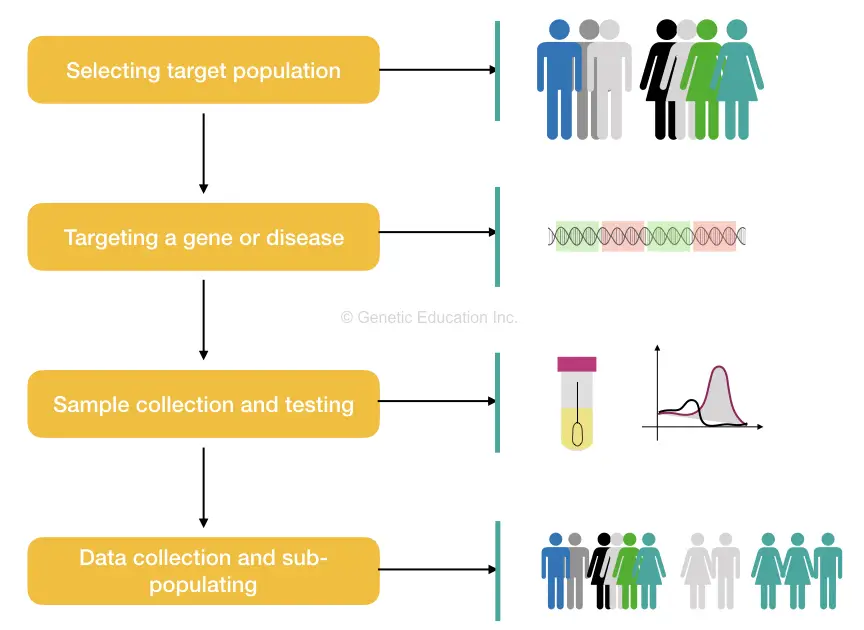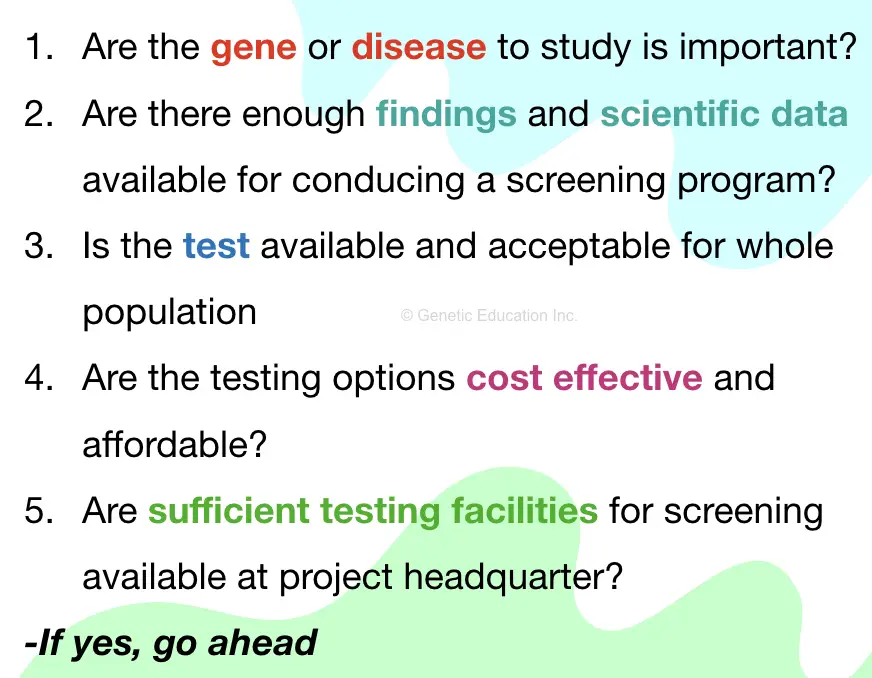“Genetic screening is the mass population testing process to identify the group of people who are having or at risk of having a genetic disease or trait.”
“Screening” is a word so often used in the medical or testing field, although its importance is not well known to everyone. The purpose of any type of screening is to gather the information from the entire population or group, identify subgroups and separate it to test, evaluate, or identify them.
For instance, genetic screening (which is not a genetic test), is performed on a particular group of population (which are at high risk of having some disease), to identify peoples having or at risk of developing the disease.
The entire screening process is performed using some genetic tests, tools or techniques.
Genetic screening is a systematic process to know something regarding the entire population. The aim of it is to separate those people or from the population who are having some kind of medical and or genetic problems.
After the discovery of DNA in 1953 by Watson and Crick, new techniques for genetic testing were evolving. Meanwhile, some other groups of scientists were continuously working on identifying and characterizing new genetic conditions or disorders.
As scientists get more and more data the idea of having genetic disease in different ethnical population, group and culture become more and more clear.
The idea of screening the whole population or ethnical group arose during 1975, though some were not in support of it.
(genetic screening based on ethnicity might cause discriminations!)
“The objective of conducting any type of genetic screening is to prevent, stop or cure the genetic disease.”-WHO.
Key Topics:
What is genetic screening?
Simply put, the present technique is used to know the status of a particular genetic disorder in a particular population or ethnic group.
Although, before understanding what a genetic screening is! We should first understand how it is different from genetic testing.
Genetic screening is a whole program that is a combination of various processes, methods, and techniques. Whilst, genetic testing is a single method, technique or process.
Using a genetic screening, a whole population is examined or tested for a particular disorder or a gene while genetic testing is a method to test one individual or a couple at high risk of having a genetic disease.
The genetic screening outcomes identify the whole subgroup which is at risk or has a disease gene or disease while using genetic testing, a carrier or disease status of some or one individual is evaluated.
Conclusively we can say, using genetic testing, test, technique or tools a genetic screening program can be performed. But genetic testing is totally a different thing.
The objectives of conducting a screening program supposed to be are,
- To study a disease or genetic disease.
- To identify a gene, mutation of genes associated with a genetic disease.
- To identify and isolate subpopulations having or at risk of carrying a mutation or disease.
- To study and map carriers from the population.
- To study and map the disease population.
- To study the phenotypic and genotypic effect of genetic disease.
The burden of genetic disorders on the world population is huge, with a variable level of occurrence in different populations.
Some are so rare! While some are more commonly present. For instance, beta-thalassemia is common in the Mediterranean, Italian and Indian populations compared with others.
On the other side, population-based data are unfavorable in the case of cystic fibrosis, present 1 in 10000 worldwide.
The objective of employing any kind of genetic screening program is simply to gather some primary data regarding the genetic status of the study population.
It gives us an idea about,
- A subpopulation of having a single disease allele (homozygous)
- A subpopulation of having two disease allele (heterozygous)
- A subpopulation having normal alleles
These are some of the crucial information that helps in risk assessment, prevention and preparing treatments for a genetic disease targeted for a genetic screening program.
Definition:
A population based screening program is performed to know a disease or carrier status of a population, thereby identifying the subgroup of having a disease gene using genetic techniques, is known as genetic screening.
Type of genetic screening programs:
- Prenatal genetic screening
- Postnatal genetic screening
- Population-based genetic screening
Prenatal genetic screening:
The present type of genetic screening program is conducted for screening fetuses to encounter various genetic anomalies. Common genetic anomalies are Down syndrome, patau syndrome, Edward syndrome, thalassemia, sickle cell anemia and Huntington’s disease.
The process of sample collection of prenatal genetic screening is referred to as amniocentesis in which amniotic fluid or chorionic villi sample is taken for testing.
Common testing techniques for prenatal genetic screening are DNA sequencing, polymerase chain reaction and karyotyping.
One of the major benefits of the prenatal genetic screening program is that one can abort affected fetus thereby decreasing the burden of genetic disorder.
In recent time, a modern method for testing and genetic screening is widely used, known as cell free fetal DNA testing. Read more on the present topic: what is cell free fetal DNA testing? How is it performed?
Postnatal genetic screening:
Postnatal genetic screening is done after the birth of the baby, however, it is the best for several types of disorders like phenylketonuria, alkaptonuria and glycogen storage disorders.
The conditions covered in the postnatal screening are categorized in the metabolic disorder, are not so lethal and can be overcomed by medications.
Population based genetic screening:
The population based genetic screening program is conducted on the entire population to screen any genetic disorder, to identify the candidate gene involved or to find out the frequency of the mutant allele in the population.
Population based genetic screening programs are very helpful to understand the etiology and epidemiology of the genetic condition in one particular population.
The process of genetic screening:
Only an expert can design, prepare and implement a genetic screening program, generally are geneticists or medical experts. The entire process can be divided into four major categories:
- Selecting and evaluating the population
- Targeting a gene or disease
- Sample collecting and testing
- Data gathering and sub populating

Selecting and evaluating the population:
Though, the whole process of screening is random, but can’t be performed randomly, indeed. A study population is first designed based on the available data and scientific publications.
During the process, inclusion and exclusion criteria are decided. For instance, if it is a prenatal screening program, though a person or baby having a genetic defect, are excluded from the study.
Contrary, if someone doesn’t have any family history of a disease, still if he or she is in the high risk study population, they are included in the study.
The reason to include or exclude peoples from the study population is to collect or get correct information as outcomes of the screening programs.
Therefore, the first step in a screening program is to select the population on which the screening program is conducted.
Targeting a gene of disease:
A screener should have to select a gene or disease on which they wish to conduct their program, in the next step.
Genetic disorders are rare! And costlier too. The cost of the overall screening program matter’s a lot. Take a look at this example.
There are several criteria to select a disease or gene;
A gene should have a distinct inheritance pattern, smaller and have low GC content. If a gene doesn’t have a clear inheritance pattern, disease progression can’t be traced.
Technically, a gene should be shorter and have a low GC content so that it can be amplified efficiently in either PCR or DNA sequencing.
There should be enough scientific data available to process, test and evaluate genes.
The disease must be associated with the gene selected for the study.
The disease must have a clear inheritance pattern.
A disease must not be infectious.
A disease must be monogenic, so that the accuracy of testing can be achieved, under cost.
Let’s take an example of sickle cell anemia and leukemia.
Mutation in the HBB gene causes sickle cell anemia has not so lethal symptoms.
It has an autosomal recessive inheritance pattern, therefore out of 4 progenies, only a single person may have the disease.
The HBB gene is a short gene and has less GC content and therefore can easily be sequenced and amplified.
Contrary,
Leukemia is a multigenic disorder, many genes and chromosomal aberrations are involved in it. Also, the clear inheritance pattern of it is still unknown.
These are the reasons one can’t select, using which technique it can be screened.
So to design a screening program on sickle cell anemia is more beneficial for screeners as well as patients than leukemia.
Sample collection and testing:
Once the target population and a gene or disease decide, the next step in the genetic program is sample collection and testing. The testing method is decided prior while designing the screening program so that the SOP can be manufactured; manpower, training and trials can be done.
Fewer testing options are available for genetic screening such as PCR, DNA sequencing, karyotyping, and DNA microarray.
A single gene defect and a few mutations can be screened using the polymerase chain reaction. It’s a cost-effective option, can identify homozygous as well as heterozygous, and easy to operate.
The DNA sequencing technique is costlier than PCR but can screen many mutations from a single as well as multiple genes.
However, due to higher testing costs, the entire genetic screening program can’t be conducted based on the DNA sequencing technique.
Karyotyping is yet another powerful technique selected for a screening program. It is a cost-effective option that is used for screening of Down syndrome, Patau syndrome, Edward’s syndrome and other chromosomal defects.
Different sample collection techniques are employed for different types of samples. For instance, amniocentesis is performed for testing the fetus, and is amniotic fluid and chorionic villi.
Blood samples are collected in a special type of EDTA and heparin vials for DNA performing polymerase chain reaction and karyotyping.
Note that all the samples must be collected by an expert in sample collection tubes, transfer to the testing facilities under strict 4C temperature and at the appropriate time.
Data gathering and subpopulating
“Data” and “statistics” are important elements of any genetic screening because it gives us a broad and overall idea about the entire population so that we can create a subpopulation based on that.
Genotypic frequency, phenotypic frequency and allelic frequency are important parameters to measure the population.
Usually, statistical methods and mathematical equations are used to generate data.
Guidelines and criteria for genetic screening program:
The genetic screening programs are tedious, time-consuming and costly processes, and henceforth WHO has given guidelines and criteria for designing a genetic screening program.
In 1968, the world health organization decided on several criteria and guidelines to design a genetic screening program.
Some guidelines are enlisted here;
Based on the available information and data; the purpose and possible outcomes of the program should be pre-decided.
It must be a voluntary process not mandatory
Preventive and beneficial prenatal genetic screening programs should be mandatory and free of cost so that everyone can take advantage of it.
To avoid discrimination, privacy and concern issues, the privacy of the individual involved in the testing should not be disclosed.
The privacy of individuals should not be disclosed without prior permission.
Prior ethical approval and consent for testing must be taken before implementing a project or test.
Treatment or cure options, if available must be provided immediately and at minimum cost.
Test procedures should cost-effective.
The criticality of tests, problems and possible outcomes must be explained to the patient prior to testing.
Besides, this question may help;
- Studying the disease or gene selected for the program is important?
- Are there enough findings and scientific data available for conducting a screening program?
- Is the test available and acceptable for the whole population?
- Are the testing options cost-effective and affordable?
- Are sufficient testing facilities for screening available at the project headquarter?
- Are diagnosis, treatment and management options available?

Importance of genetic screening:
Mutation or alteration in DNA, genes or chromosomes can cause genetic disorders; broadly categorized into inherited and non-inherited genetic disorders.
The inherited genetic defects can pass on to their offspring and can cause disease in them as well. Therefore prevention of inherited genetic defects or disorders is a major concern for governments.
Besides, it can also be categorized into monogenic and polygenic genetic disorders. The monogenic disorders are single gene defects that arise due to mutations in a single gene, for example, sickle cell anemia. Polygenic effects arise due to multiple genes.
Testing limitations favor only single gene- monogenic defects; only be selected for genetic screening programs.
To avail early management or cure and to prevent the spread of inherited monogenic disorders, genetic screening programs or population-based genetic screening programs are conducted.
Take a look at the burden of various genetic defects worldwide.
The chart of the burden of genetic disorders worldwide
Any type of genetic screening program is conducted to fulfill several groundbreaking objectives. Some of the testing methods for that are:
Disease testing, career testing, presymptomatic testing, prenatal genetic testing, etc, one of which can be employed for a genetic screening program.
Application and advantages:
By only testing a single or couple of people, we can’t get enough information related to a disease or genetic condition.
A large-scale genetic screening allows us to get more and more data to evaluate and study the condition thereby providing enough information for management and treatment options.
The prevalence of a disease in a particular micro or macro population can be calculated.
The frequency of the mutant gene and allele can be calculated using the genetic screening method, more data leads to accuracy in the mapping process.
Homozygous and heterozygous– carrier conditions can be encountered by the entire population. By utilizing the biostatistics parameters the cumulative frequency of mutant allele can be calculated from the whole population.
Genetic screening of the whole population gives us a rough idea about the epidemiology of genetic conditions from a population.
Prenatal, neonatal and population genetic screening allows us to identify a subgroup of people suffering from the disease.
Disadvantages:
Besides having tremendous advantages in gathering information related to genetic conditions, there are a couple of disadvantages of genetic screening.
The data of the genetic screening are of the whole population not a single person.
This means that if the frequency of the mutant allele is very high in some populations, it doesn’t mean that all the individuals of that population are at equal risk!
As it is not mandatory to include or force everyone to be involved in the screening, the data and results are not so accurate, though enormous.
Conclusion:
With individual genetic testing, genetic screening on population or mass genetic screening programs are needed in every country to know the status of various genetic diseases.
Governments of different countries have to approve more and more genetic screening programs which ultimately help us to decrease the genetic disease burden globally.


